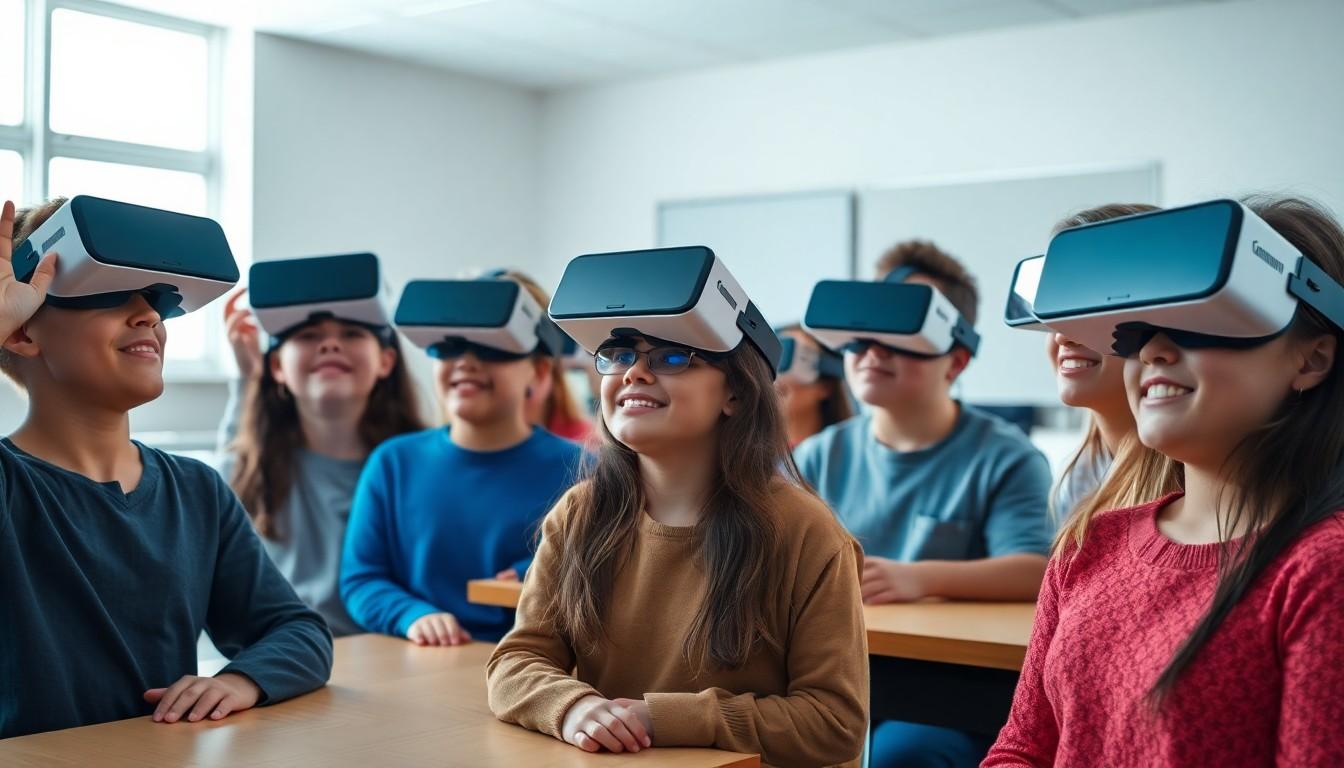Table of Contents
ToggleImagine diving into the depths of the ocean without getting your feet wet or exploring ancient civilizations without the need for a time machine. Educational VR apps are turning the classroom into an exhilarating adventure, making learning feel more like a thrilling video game than a mundane lecture. With the power of virtual reality, students can engage with subjects in ways that textbooks simply can’t compete with.
Overview of Educational VR Apps
Educational VR apps offer innovative learning opportunities through immersive experiences. These applications range from exploring distant planets to walking through historical landmarks. They enable learners to engage with material in dynamic ways, enhancing retention and understanding.
Various subjects benefit from VR integration. Science students can conduct virtual lab experiments without physical limitations. History classes provide experiences like visiting ancient Rome or watching historical events unfold, making them more relatable and engaging.
Many educational institutions adopt VR technology to enhance curricula. Schools, colleges, and universities recognize its potential to improve learning outcomes. Evidence shows students demonstrate greater enthusiasm when using VR apps compared to traditional methods.
Accessibility emerges as a significant advantage of educational VR apps. Devices like Oculus Quest or HTC Vive allow learners from different backgrounds to access high-quality content. Experiential learning opportunities foster inclusivity, bridging gaps in educational resources.
Data demonstrates that students using VR demonstrate higher motivation and engagement levels. In one study, 93% of students expressed interest in continuing their learning through VR experiences. Such responses highlight the positive impact of immersive technology on educational practices.
Right now, educational VR apps continue to evolve. Developers regularly update content to align with new standards and provide enhanced features. Collaboration among educators, developers, and researchers also enhances the quality and relevance of VR applications.
Benefits of Educational VR Apps
Educational VR apps provide unique benefits that enhance the learning experience, making subjects more immersive and interactive.
Enhanced Learning Experiences
Immersive technology transforms how students learn by allowing them to interact with content. For example, learners can virtually explore the solar system or ancient cities, creating vivid memories. This hands-on approach fosters deeper understanding and retention. Additionally, VR simulations enable students to conduct virtual experiments that replicate real-world scenarios. These activities cater to various learning styles, appealing to visual and kinesthetic learners alike. Evidence shows that students grasp complex concepts more effectively when engaged in immersive environments. By breaking geographical and temporal barriers, educational VR apps ignite curiosity and promote exploration, making learning feel like an adventure.
Increased Engagement and Motivation
Engagement levels soar when students use VR apps in the classroom. Statistics reveal that 93% of students express interest in furthering their learning through these immersive tools. The interactive nature of VR captivates attention and keeps learners focused on the task at hand. Creating engaging experiences allows students to visualize and actively participate in their lessons. Furthermore, schools that integrate these innovations see increased enthusiasm among students compared to traditional methods. Gamified elements, like challenges and rewards in VR apps, motivate learners to pursue knowledge actively. As a result, the educational landscape evolves, making learning more appealing and accessible to everyone.
Popular Educational VR Apps on the Market
Several educational VR apps are reshaping the learning landscape by providing immersive experiences that captivate students and enhance knowledge retention.
App 1: Features and User Feedback
“Google Expeditions” enables users to embark on virtual field trips to places like the Great Wall of China and the depths of the ocean. Users can experience real-world environments firsthand, exploring various historical sites and natural wonders. Feedback highlights the app’s ease of use and extensive content library, with many educators praising its ability to engage students actively. Over 70% of teachers report improved student participation during lessons that include this app.
App 2: Features and User Feedback
“zSpace” offers a unique blend of AR and VR experiences for subjects like biology and engineering. Its interactive simulations allow students to dissect virtual frogs or assemble complex structures. Teachers appreciate zSpace for its hands-on learning approach, which caters to different learning styles. Positive user reviews often mention enhanced critical thinking skills, with 85% of students feeling more confident in their understanding of complex concepts after using the app.
App 3: Features and User Feedback
“CoSpaces Edu” empowers students to design and build their own virtual worlds, fostering creativity and collaboration. This app allows learners to code and animate their creations, integrating various subjects through engaging projects. User feedback reveals high satisfaction rates, with 90% of students expressing excitement about sharing their projects with peers. Educators report that CoSpaces enhances problem-solving abilities and encourages teamwork among students, creating a cooperative learning environment.
Challenges and Limitations of Educational VR Apps
Educational VR apps face several challenges and limitations that can impact effectiveness.
Accessibility Issues
Access to educational VR apps remains a significant concern. Not all students can afford high-end devices like Oculus Quest or HTC Vive. Economic disparities create barriers for learners from low-income backgrounds, restricting their involvement in immersive education. Limited availability of platforms often hampers the reach of VR content in certain regions, especially in underfunded schools. Moreover, technical proficiency varies widely among students, affecting their ability to engage with advanced technologies. An inclusive approach is crucial to bridge these gaps and ensure equitable access to educational resources.
Technical Limitations
Technical limitations affect the overall effectiveness of educational VR applications. Many devices require robust hardware, which can deter some educational institutions from widespread implementation. Performance issues, such as lag or low frame rates, detract from the immersive experience, diminishing student engagement. Compatibility across various platforms may create challenges, making it difficult to standardize the use of VR in classrooms. Furthermore, the learning curve associated with using VR technology can hinder quick adoption, delaying its potential benefits in the educational realm.
Future Trends in Educational VR Apps
Emerging trends in educational VR apps point toward increased personalization of learning experiences. Developers are integrating adaptive learning algorithms to tailor content based on individual student needs and progress. Enhanced assessment tools provide real-time feedback, allowing educators to monitor student performance closely and adjust lessons as necessary.
Collaboration among students may also improve with the rise of multi-user VR environments. These settings enable learners to interact with each other while exploring virtual worlds, promoting teamwork and communication skills. With the gamification of learning experiences, students are more likely to engage actively and enjoy the educational process.
Another significant trend includes the incorporation of artificial intelligence into VR apps. AI-driven systems can analyze user behavior, adjusting challenges to maintain appropriate skill levels and keep learners motivated. Interactive storytelling features combined with immersive content will create more dynamic learning situations.
Accessibility solutions are evolving to ensure that VR technology is available to all students. Lower-cost devices and platforms are emerging, making it feasible for various educational institutions to adopt this technology. Developers are also focusing on user-friendly interfaces, reducing the barrier for teachers and students alike.
In terms of content updates, VR apps will continue to align with rapidly changing educational standards. Ongoing partnerships between educational institutions and technology companies expedite the integration of the latest curriculum developments. As augmented reality merges with virtual reality, hybrid applications will likely enhance learning experiences even further.
Stretching beyond educational settings, partnerships with museums and cultural institutions will provide unique learning opportunities. Collaborative experiences that leverage real-world artifacts will deepen students’ understanding of complex subjects. Thus, the future of educational VR apps promises not only accessibility and engagement but also richer, more meaningful educational experiences.
Conclusion
Educational VR apps are revolutionizing the way students learn by providing immersive experiences that capture their imagination. These tools not only enhance engagement but also cater to diverse learning styles, making complex subjects more accessible and enjoyable.
As technology continues to advance, the potential for personalized learning and collaborative environments expands. Schools and institutions are increasingly recognizing the value of VR in fostering enthusiasm and improving educational outcomes.
With ongoing developments and partnerships, the future of educational VR apps looks promising, paving the way for richer and more meaningful learning experiences for students everywhere.





